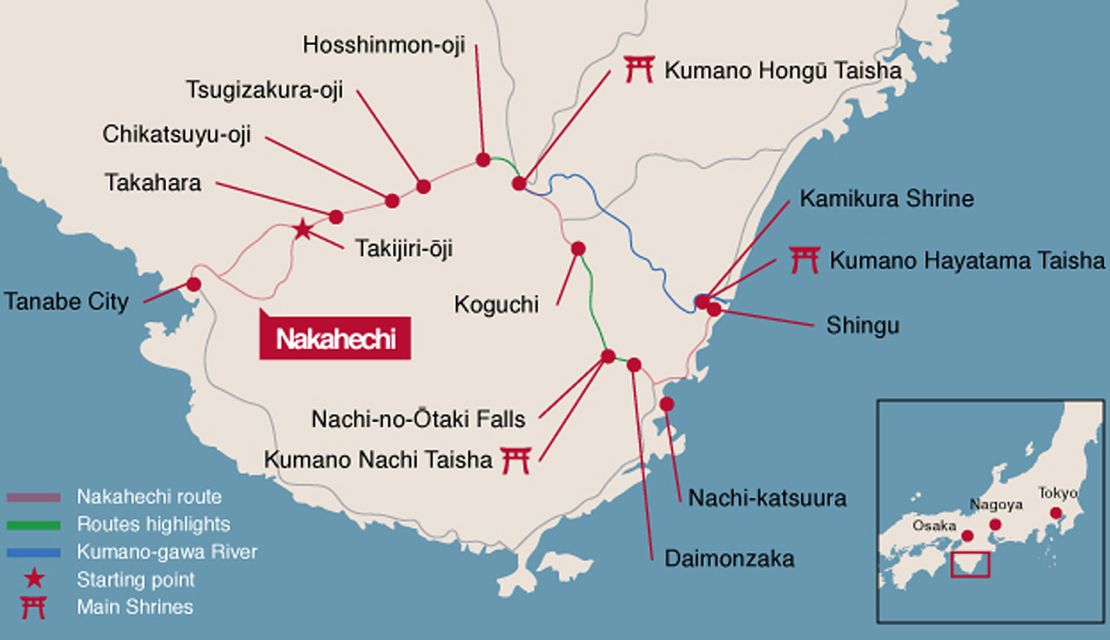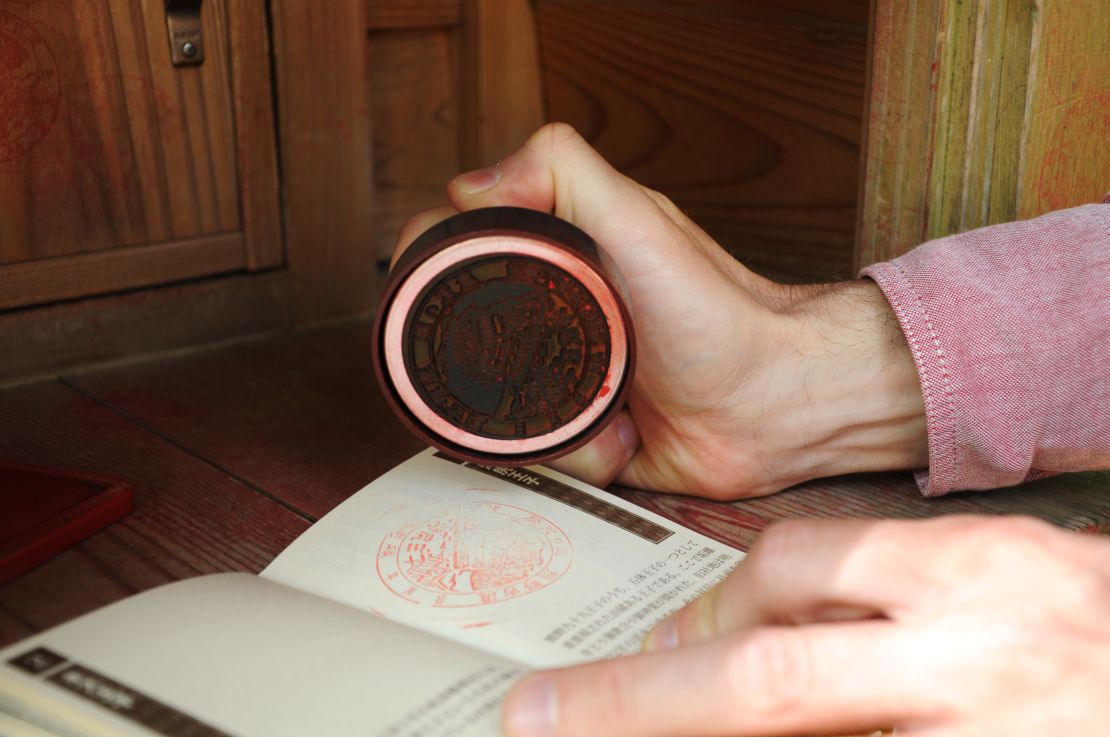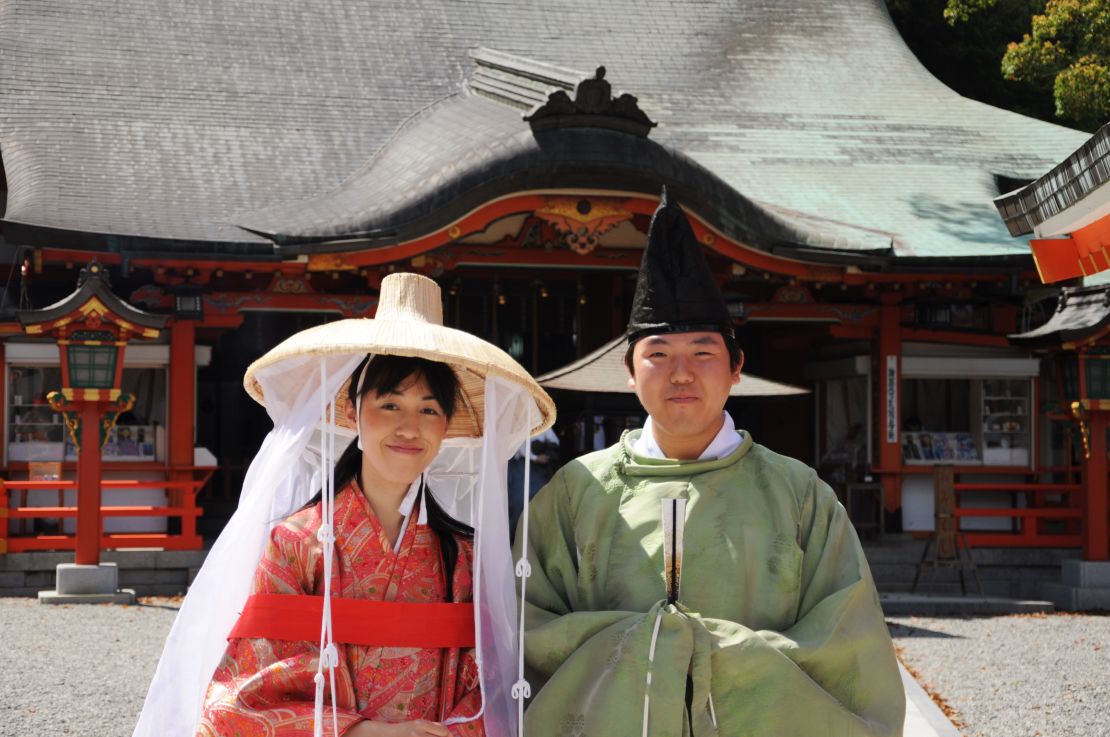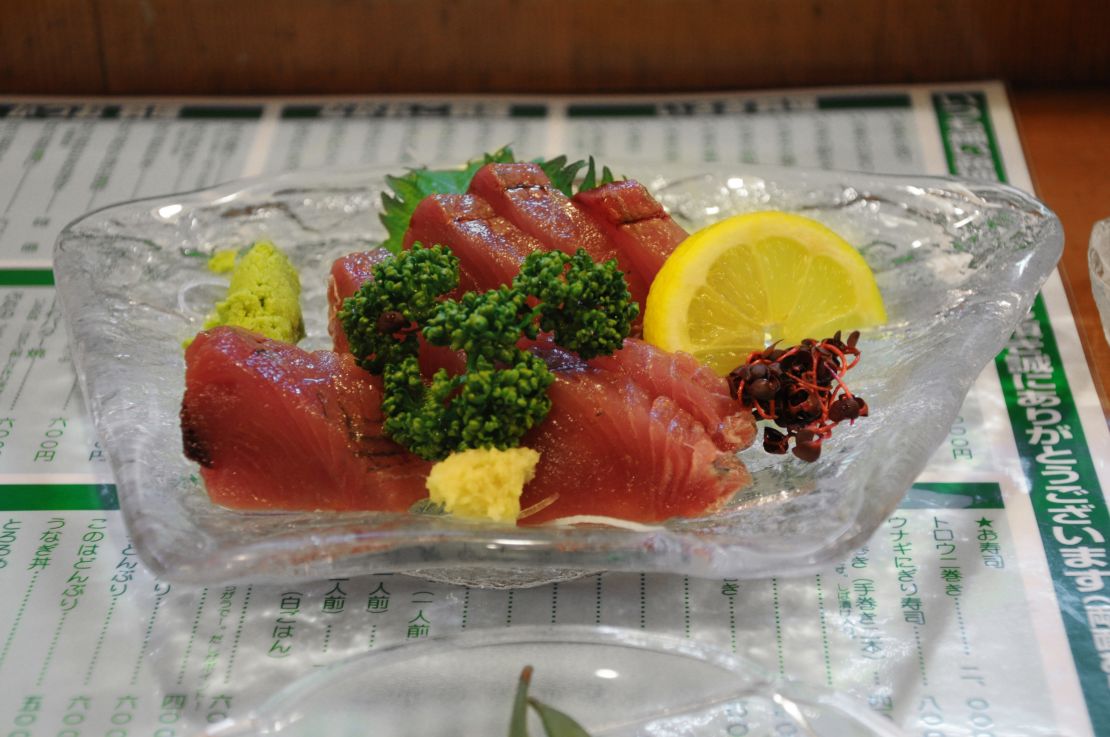Editor’s Note:
Story highlights
Kumano Kodo is one of two UNESCO-listed pilgrimages
Kumano Kodo is a network of seven pilgrimage routes and Nakahechi is the most popular
For the big trek-averse, travelers can choose to take short hikes easily accessed by public transport
I knew I was going to have to climb 538 stairs to get to Kamikura Shrine in Wakayama, Japan. What I didn’t know was that those steps – leading to the lofty highlight of my Kumano Kodo pilgrimage – would be on a 70-degree incline.
Ever tried climbing a rock face? Or the roof an A-frame house? Run a rolling pin over your calves a few times and you’ll get an idea of what I was looking at.
Already exhausted from hiking Kumano Kodo’s ancient trails in the Kii Mountains – the route starts about an hour by train from Osaka – the only things pushing me upward were the encouraging smiles from a grandpa, a girl wearing a long maxi-dress and salarymen in stiff shirts and dress pants who walked past me as if they were taking a stroll to the grocery store.
So, was that uphill torture worth it? Of course – what great hike isn’t?
Anyway, the rest of the trail was relatively easy to get through – the biggest obstacle was all the stops for photos.
And there is good reason for that. The views and little stops along the way make this one of the best (and possibly most overlooked) treks on the planet, a glorious march – or in my case, occasional scramble, that includes hot springs retreats, delicious local food and rich cultural insight into a relatively unexplored part of Japan.
When I say unexplored, I mean for international travelers. Though the pilgrimage has been in operation for more than 1,000 years it remains quite off the map for most visitors to Japan who consider Kyoto or Osaka a far enough detour from the main access point of Tokyo.
And this is a good thing – because it means a richer, more peaceful experience for those that make it to Wakayama prefecture and the Kumano Kodo. And for those that think Japan is expensive, food and accommodation prices are better than reasonable.
This guide will give you all to know to capture a truly epic adventure. And like most epic adventures, there’s a bit to it.
10 things that make Wakayama Japan’s best-kept secret
The religious stuff

Before getting too carried away with directions and recommendations, a step back.
Kumano Kodo is the name of a hiking route made up of seven trails that snake through the Kii Mountain Range in Japan’s Wakayama prefecture. As you can see by the inset map it is about 100 km south of Osaka.
It’s one of only two pilgrimages in the world registered as a UNESCO World Heritage Site. (Spain’s Way of St. James is the other.)
To characterize the experience solely as “a pilgrimage” doesn’t do Kumano Kodo justice.
Though there is some stiff competition, Kumano Kodo just might be one of the world’s top nature hikes.
The route dates back more than a thousand years, when imperials and aristocrats took weeks-long journeys from as far away as Kyoto to hit up the area’s three major Buddhist/Shinto shrines, Kumano Hongu Taisha, Kumano Hayatama Taisha and Kumano Nachi Taisha.
Together, the trio of shrines is referred to as Kumano Sanzan.
Instead of a 30-day commitment (as walkers doing Way of St. James sign up for), Kumano Kodo’s infrastructure makes it possible even for the exercise-averse or time poor to enjoy the area’s mountains, cedar-filled forests, farms and hot springs.
If you don’t have the strength, time or desire to do the entire pilgrimage – not everyone considers walking 40-plus kilometers a holiday – there are other ways to take in the highlights (the gallery above shows most of those).
Kumano Kodo has a good transportation network that allows hikers to bite off shorter walks by traveling to various points along the route by bus or train.
The full Kumano Kodo hiking experience takes four or five days.
Rafting in Wakayama: It’s on logs – and standing up!
Help from higher authorities
Regardless of spiritual beliefs, most visitors find it’s useful to learn about the local religious culture before embarking on the Kumano Kodo experience.
Along the way, walkers encounter about 100 “oji” (subsidiary shrines of Kumano Sanzan), at which Japanese pilgrims stop and offer prayers.
The oji’s purpose is to enshrine natural landmarks in the area – be it an ancient tree or a majestic waterfall.
Here’s the routine: drop a coin in the donation box in front of the shrine, ring the bell above the box, bow twice and clap twice, pray then bow once more. Got it?
“Any coin is fine, but the most common is the five-yen coin, called ‘goen’ in Japanese,” says Brad Towle, director of Tanabe City’s international tourism promotion and development department.
“It means ‘good relationship’ and offers hopes for a bonding with God.”
Yuasa: Birthplace of Japanese soy sauce
Where to start

Among the seven major Kumano Kodo routes, Nakahechi, which stretches from Tanabe City in the west to Shingu in the east, is the most popular and what we are focusing on here.
Local buses run from Tanabe City’s KiiTanabe train station to Takijiri-oji, the entrance of Kumano Kodo and beginning of the Nakahechi route. (Check out the “Getting around” section at the end of this article for the link to an English-language bus schedule.)
Here you’ll find an information center offering details on the route, as well as free bamboo hiking sticks and a booklet to fill with stamps from various landmarks along the hike.
Bamboo stick in hand and five-yen coins in pocket, Kumano Kodo hikers usually reach the Chikatsuyu-oji mini shrine in Nakahechi on the first day. It’s about 16 kilometers from the Takijiri-oji entrance and takes about six hours of walking.
The following day is a whopper – hikers trek 26 kilometers from Chikatsuyu-oji to reach Kumano Hongu Taisha, the first main shrine on this route.
Kumano Hongu Taisha was relocated to its current location from Oyunohara after being salvaged from floods in 1889.
There’s a large exhibition hall and information center nearby with an interesting mix of details on the pilgrimage.
Most pilgrims then take the 90-minute boat ride from Hongu down the Kumano-gawa river to Kumano Hayatama Taisha and Kamikura Shrine in Shingu – the one with all those steps.
(Click on the map above for an enlarged look at all the routes.)
Hayatama Taisha enshrines a beautiful 800-year-old nagi tree; Kamikura Shrine pays tribute to a gigantic rock, Gotobiki-iwa, on top of Gongen Mountain.
Before heading to the last grand shrine of Kumano Nachi Taisha and the stunning Nachi Falls, pilgrims enjoy one of the easiest walks of the journey, which starts from Daimonzaka. (To get there, visitors can hop on one of the regular buses that pass through Shingu and get off at Daimonzaka.) This section of the hike is on a gentle slope made up of cobblestone stairs lined on both sides with gorgeous Japanese cedars.
Scenery aside, it’s a great place to take in some old school cosplay action. Plenty of pilgrims head for Daimonzaka and change into traditional Heian-era kimonos from the 8th century.

“We dress up in these old kimonos once a month and walk to Kumano Nachi Taisha,” a 27-year-old walker from Osaka named Sanae Takano told me as we shared a stretch of trail.
“It’s the fourth time we’ve visited the Nachi Taisha in traditional kimonos,” added her companion, Toshifumi Kurinobu. “It’s how the earliest pilgrims traveled in ancient times.”
Heian kimonos can be rented at the Daimonzaka Chaya teahouse by hikers who want to dress the part.
Best short route: Hosshinmon-oji to Kumano Hongu Taisha
Another easy walk is the Hosshinmon-oji to Kumano Hongu Taisha route. (See the green line on the map.)
“This walk takes about two hours through forests and farming communities,” says Towle, of Tanabe City’s international tourism promotion and development department. “It ends at Hongu Taisha, the grand shrine.”
When I walked the route, I stopped at the Fushiogami-oji Chaya (tea shop), which is run by a group of volunteers of a local women’s association.
In addition to volunteering at the shop, Matsumoto Seiko leads tours around the Hongu shrine.
“I have led 12 tours in April alone,” said Matsumoto, who was born and raised in the area.
“When I was younger, I was working in Osaka. My accent from the countryside made me very conscious and shy, but since my hometown has been registered as a UNESCO World Heritage Site, I’m so proud to introduce it to others.”
In addition to tea, the shop serves shiso juice and coffee made from local hot spring water.
Meet the cat in charge of Japan’s Kishi Station
Up for a challenge? Try this route, tiger
Fit pilgrims will want to hit the 14.5-kilometer route between Koguchi and Nachi, which is said to be the most challenging section of the pilgrimage.
“It’s a three-hour hike up the mountain from the 60-meter high village of Koguchi to 800 meters at the peak,” says Towle.
“Going down the other way to Nachi is just as bad. That’s why it has a nickname – ‘sore-back slope.’”
Where to stay

Chikatsuyu-oji and Kumano Hongu Taisha are the towns where most Kumano Kodo visitors crash for the night – both offer plenty of accommodation options.
With its three historic onsen (hot spring) areas, Hongu is particularly popular.
Yunomine Onsen has a small public booth beneath the bridge and a public hot spring pool. Wataze Onsen has a public swimming pool that can be accessed for a nominal fee.
I stayed at Fuziya (rates from JPY14,700/$151 per night, including two meals), one of the two bigger ryokans (guesthouses) at the Kawayu Onsen. It’s the only place where holes are dug along the river to create natural outdoor bathing areas.
Travelers with enough time might want to consider the Takahara Kiri-no-Sato (Village of Mist) rest area.
Just four kilometers from Takijiri-oji on the way to Chikatsuyu (which you’ll recall is the most common first stop on the Kumano Kodo trail), the area is known for its mystic, foggy mountain scenes.
Takahara Lodge (rack rate from JPY10,444/$107, including two meals) has a scenic dining area at the terrace, which is sometimes used for concerts.
A rental house overlooking the mountains is also available (JPY6,930/$71 per night).
What to eat
The local Wakayama food is as fulfilling as the pilgrimage itself. And far less exhausting to deal with.
Booths set up by local villagers dot the trails of Kumano Kodo, each offering different local products for hikers, from homemade lunchboxes to hot tea and handicrafts.
Transactions are based on the honor system – travelers drop the requested amount in the collection box and take the objects of their choice with them.
Restaurants in Tanabe City and Nachi Katsuura are famous for their fresh local produce.
Bonito tuna is a star, whether eaten raw or the creative soft-fried version found in Bodai, Nachi-Katsuura.

In Tanabe City, there are more than 200 restaurants cramped in a few alleys that make up Ajikoji, or Corner of Tastes.
While fish markets usually open early in the morning, the port of Tanabe City operates in the afternoon servicing local restaurants.
Shinbe is a family-run restaurant with memorable bonito tuna sashimi.
“Restaurants here mostly serve locals instead of tourists, so they must be very good and affordable at the same time,” says Towle.
That said, English menus are available in many of the restaurants.
Other local specialties include umeboshi (pickled Japanese apricot), oranges and whitebait (baby sardines).
10 of the world’s most amazing long-distance trails
Getting there and around
From Osaka’s Kansai Airport, take the JR line to Hineno Station in Wakayma prefecture, where you can transfer to an express train to head for KiiTanabe Station in Tanabe City. Local Ryujin buses run from KiiTanabe station to Takijiri-oji.
The bus will continue along major locations on the Nakahechi route from KiiTanabe Station to Hosshinmon-oji (through Kumano Hongu Taisha). More local bus information can be found here.
Accommodation and transportation can be booked in advance through Tanabe City’s tourism website.
The tourism office acts as a community-based travel agent who bridges communication between local businesses – normally run by non-English speakers – and international travelers.
More resources can be found on Wakayama’s Kumano tourism website.
CNN’s On the Road series often carries sponsorship originating from the countries we profile. However CNN retains full editorial control over all of its reports. Read the policy




















